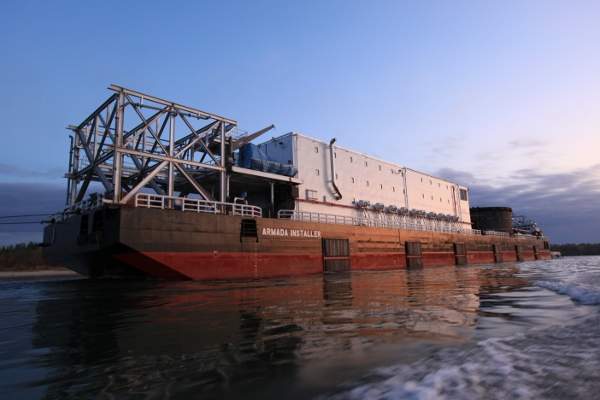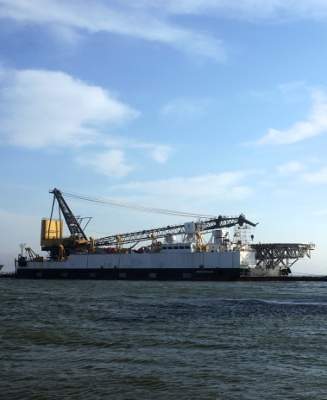Vladimir Filanovsky Field is located approximately 50km offshore, in the northern part of the Caspian Sea.
The field was discovered by Lukoil in 2005 and began production in October 2016.
The investment for the construction of the offshore field and its ancillary equipment is expected to be approximately $2.3bn. The field contains oil with 0.1% sulphur content.
Vladimir Filanovsky Field has gas and oil located within the Albian and Aptian stages, and the Neocomean superstage of the early Cretaceous sediments in water depths of 10m.
The field’s reserves are estimated to include 153.1 million tonnes of oil and 32.2 billion cubic metres of gas.
Vladimir Filanovsky offshore field infrastructure
The existing infrastructure at the Vladimir Filanovsky offshore field includes an ice-resistant fixed platform (IRFP-1), a living quarters module platform (LQM-1), a central processing platform (CPP) and a risers block (RB) platform, which is linked with connection bridges.
The 15,200t IRFP-1 is used for drilling and operation of wells. The field is producing through five wells, with average production in June 2017 exceeding 14,000t of oil.
A sixth well for water injection was completed in July 2017. The drilling of an additional seventh well for water injection also commenced during the same period..
The CPP weighs 21,000t and is used for processing and piping the oil and gas ashore. The RB platform connects the infield pipelines with export pipelines. The LQM-1 accommodates 125 people, including a helipad.
The ice-resistant offshore platforms are connected to the Yury Korchagin fields through the pipelines.
Construction works included the laying of 330km of subsea pipeline and 350km of onshore pipeline.
The project also involved the construction of an onshore terminal with a storage capacity of 80,000m³, located in the Republic of Kalmykia.
Oil and gas from the onshore terminal is transported to the Caspian Pipeline Consortium’s pipeline.
The oil is treated using two processing lines, with each line capable of processing three million tonnes a year.
The second stage of field development commenced in June 2017, and will include the construction of the IRFP-2 and LQM-2 platforms.
Construction and assembly of the two platforms is expected to be complete by the end of 2017.
Construction of the offshore platforms
Assembly of the parts for the transport and installation barge (TIB) that was used for construction of the offshore platforms commenced in December 2012.
The barge, measuring 140.3m-long and 62.3m-wide, was delivered in mid-2013.
The TIB features a loading capacity of 13,450t and was used for pile mounting the structures of the offshore platforms, as well as installing the connecting catwalk bridges using a 400t offshore crane.
It also assisted in the installation of the topside sections for IRFP-1, CPP and LQM-1.
Two additional pontoons were attached to the TIB for this purpose, alongside the original two pontoons.
The construction of the subsea pipeline system to connect the two offshore fields began in April 2012.
The pipeline measures 40km in length and is equipped with band anodes, a three-layer polypropylene coating and a solid concrete ballasting coating.
Contractors involved with the Caspian Sea-based project
United Shipbuilding was contracted to supply IRFP-1. The CPP was supplied by Globalstroy Engineering, while the platforms LQM-1 and RB were supplied by Krasnye Barrikady Shipyard.
Saipem conducted the transportation and installation of the platforms and bridges.
The company was also contracted to lay two 114km-long export pipelines from the RB to the landfall. The oil pipeline has a diameter of 22in, whereas the gas pipeline is 28in in diameter.
The construction works were carried out using the Costoro 12 and Costoro 16 barges.
Bumi Armada was responsible for laying the nine starting sections of the subsea pipelines from the RB, measuring 90km in length.
The construction was carried out using the company’s barge Armada Installer, which has a gross tonnage capacity of 10,850t and is capable of laying pipes at water depths of up to 300m. The contract is valued at approximately £200m.
The overall concept and design for the development of the offshore field was prepared by CNGS Group.
Three platform supply vessels (PSVs) for the development were supplied by Palmali Shipping Services and Agency.
Heinen & Hopman received a contract to provide HVAC equipment for IRFP-2 of the Vladimir Filanovsky Field in June 2016.
Related content
Kirinskoye Gas and Condensate Field, Sea of Okhotsk, Russian Federation
Kirinskoye will be the first offshore field in Russia to utilise a subsea system for natural gas production. The field is expected to deliver its first gas during 2012.
Lukoil’s Kravtsovskoye (D-6) Oil Field, Russian Federation
Lukoil’s Kravtsovskoye (D-6) oil field is located in the Russian sector of the Baltic Sea. It was discovered in 1983 at a distance of 22.5km from the coast of Kaliningrad region. The depth of the water is 25m to 35m.






